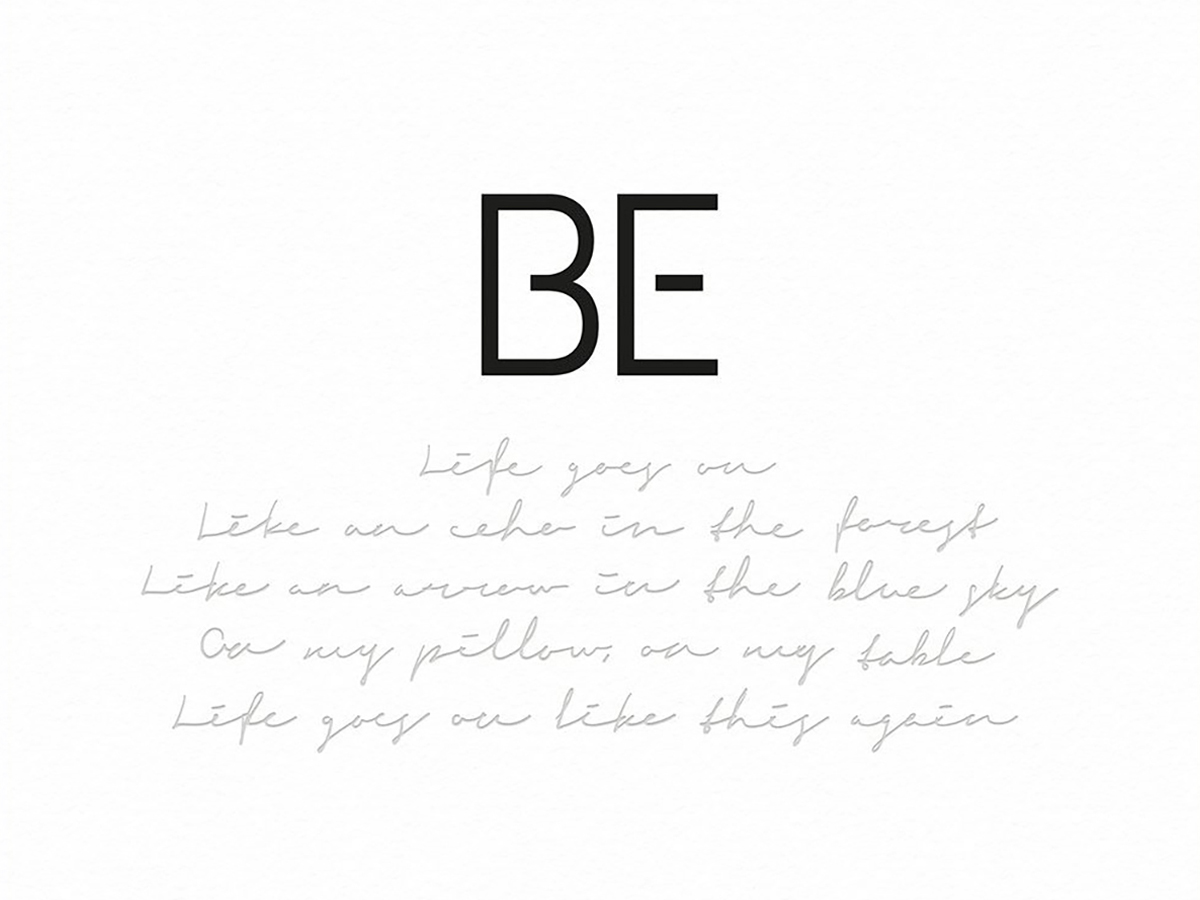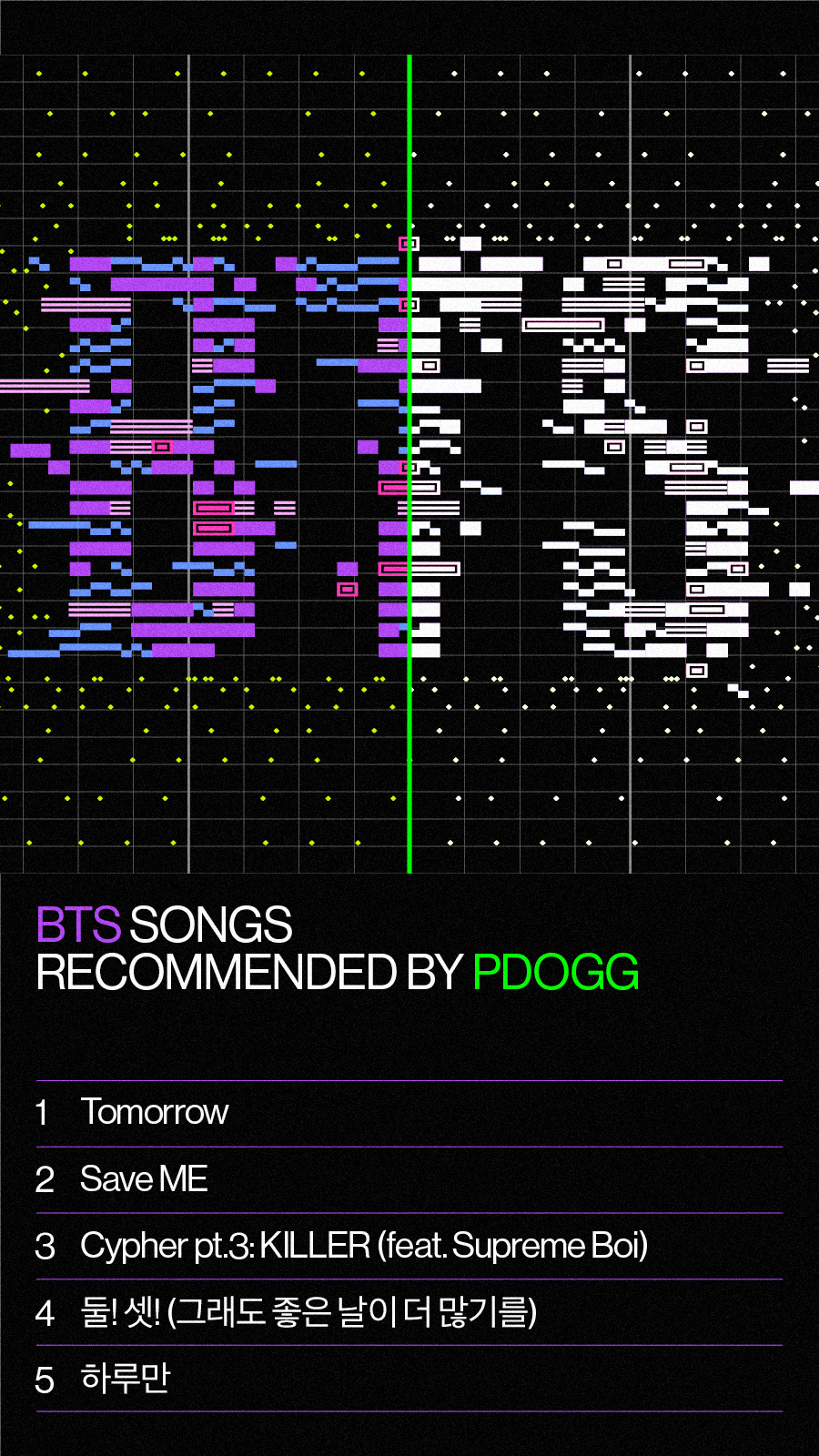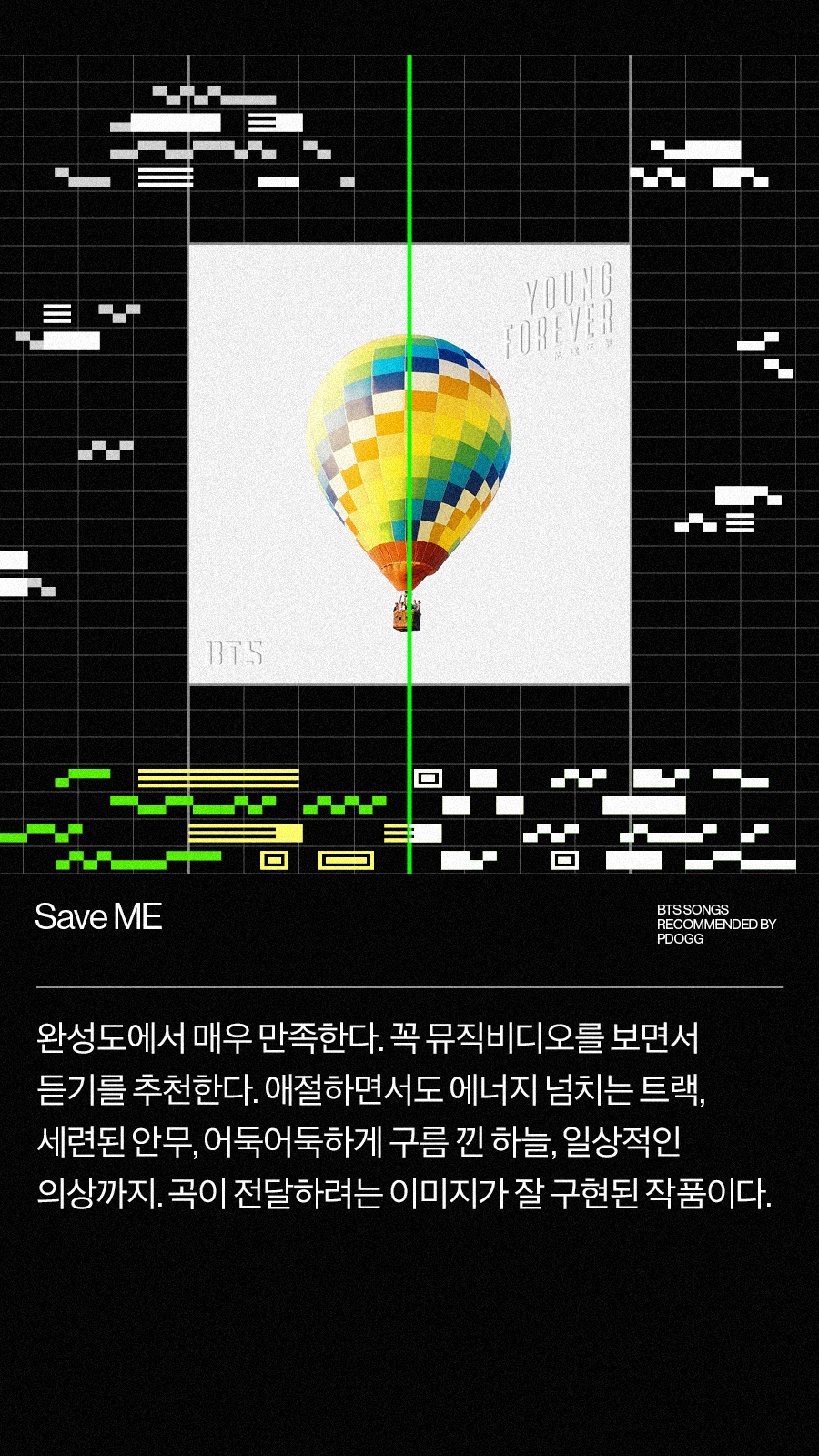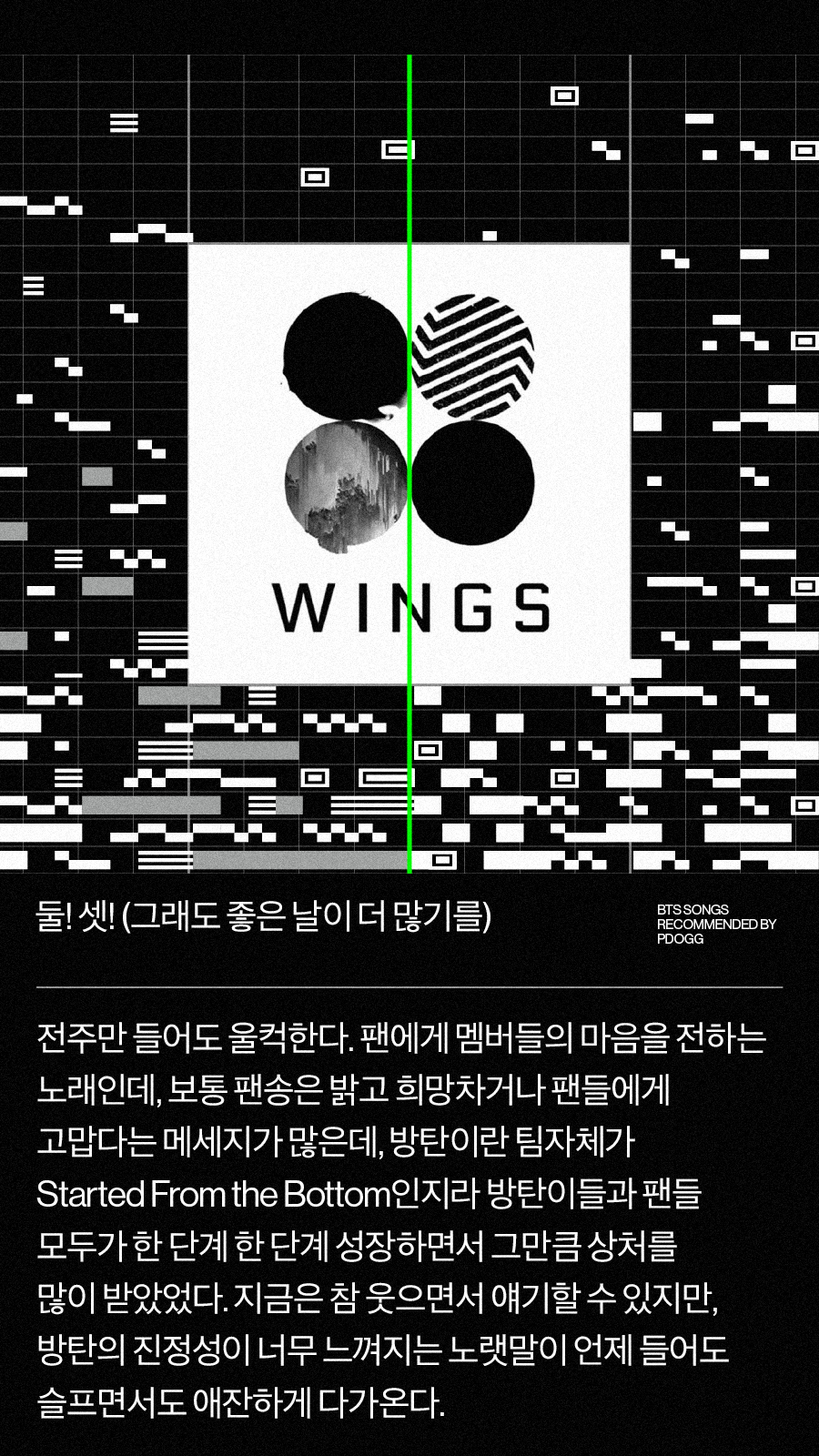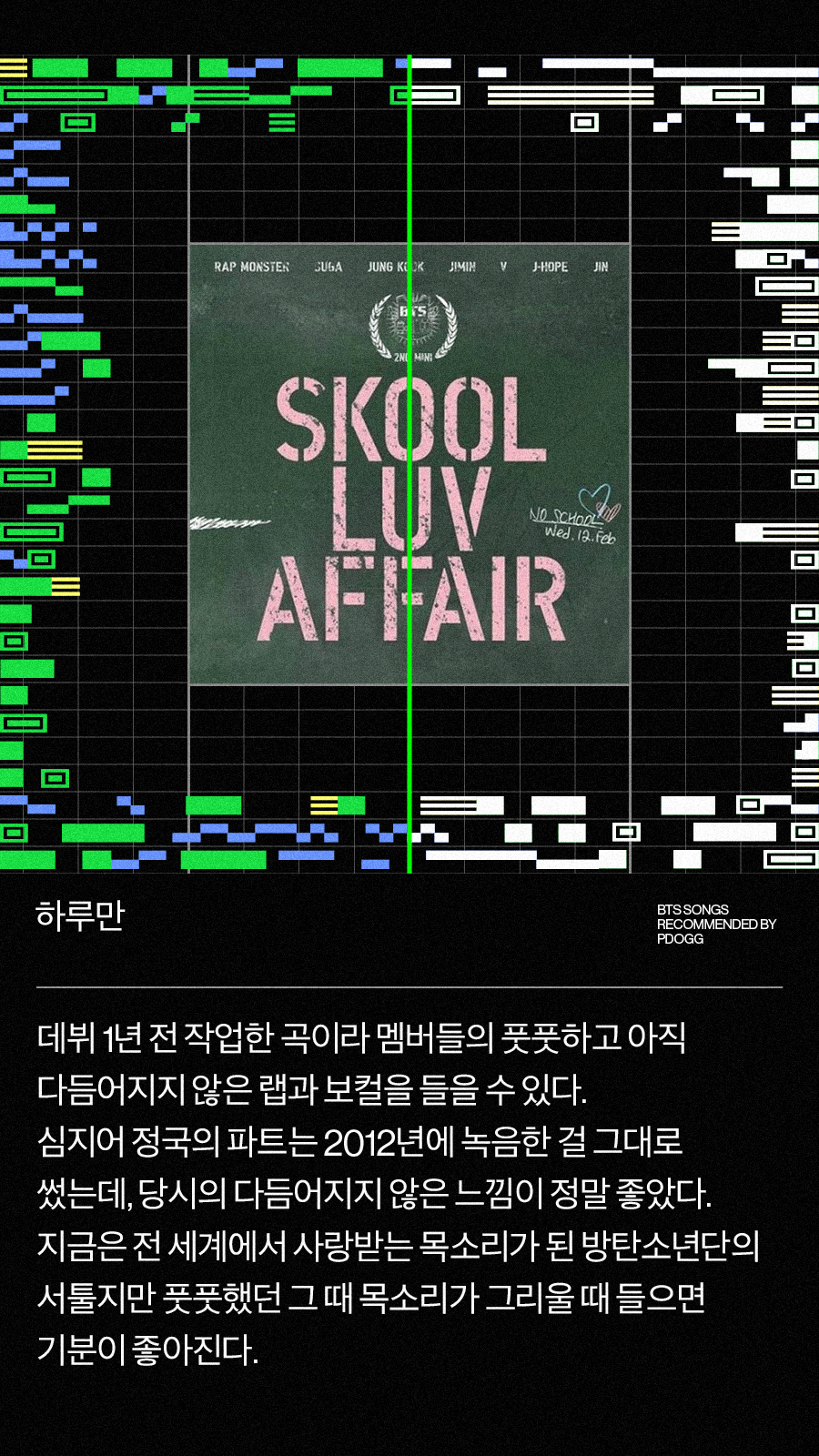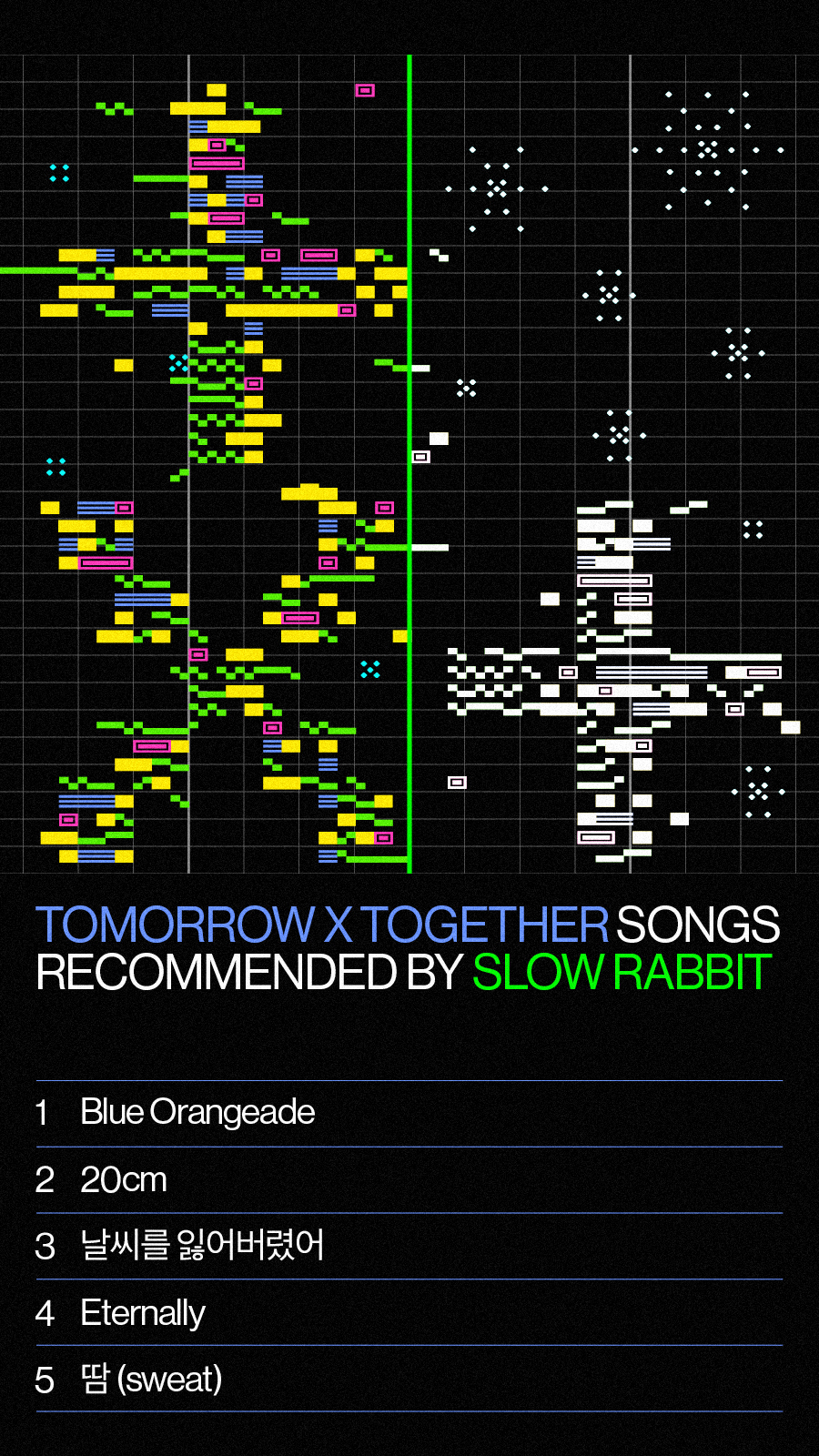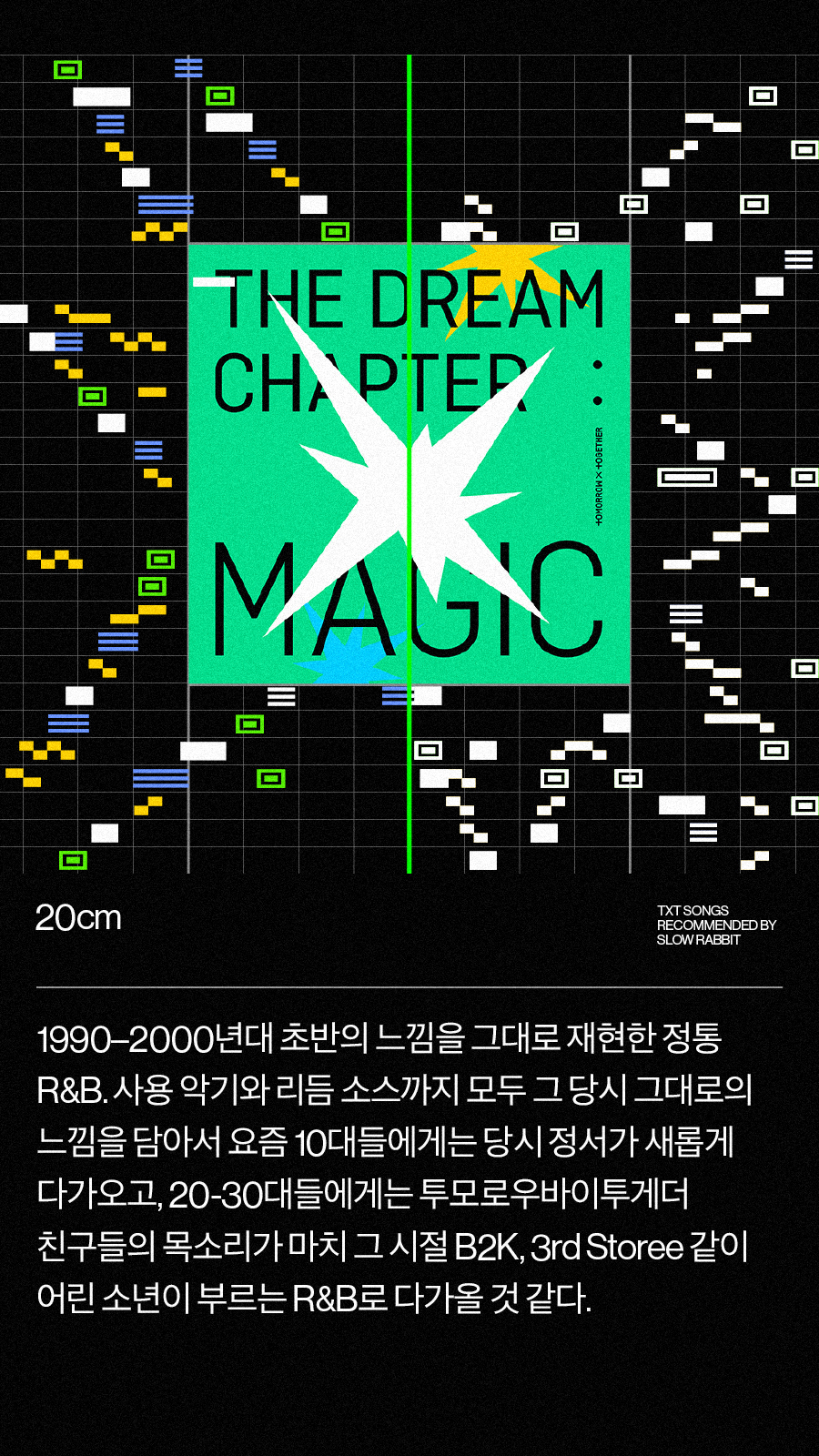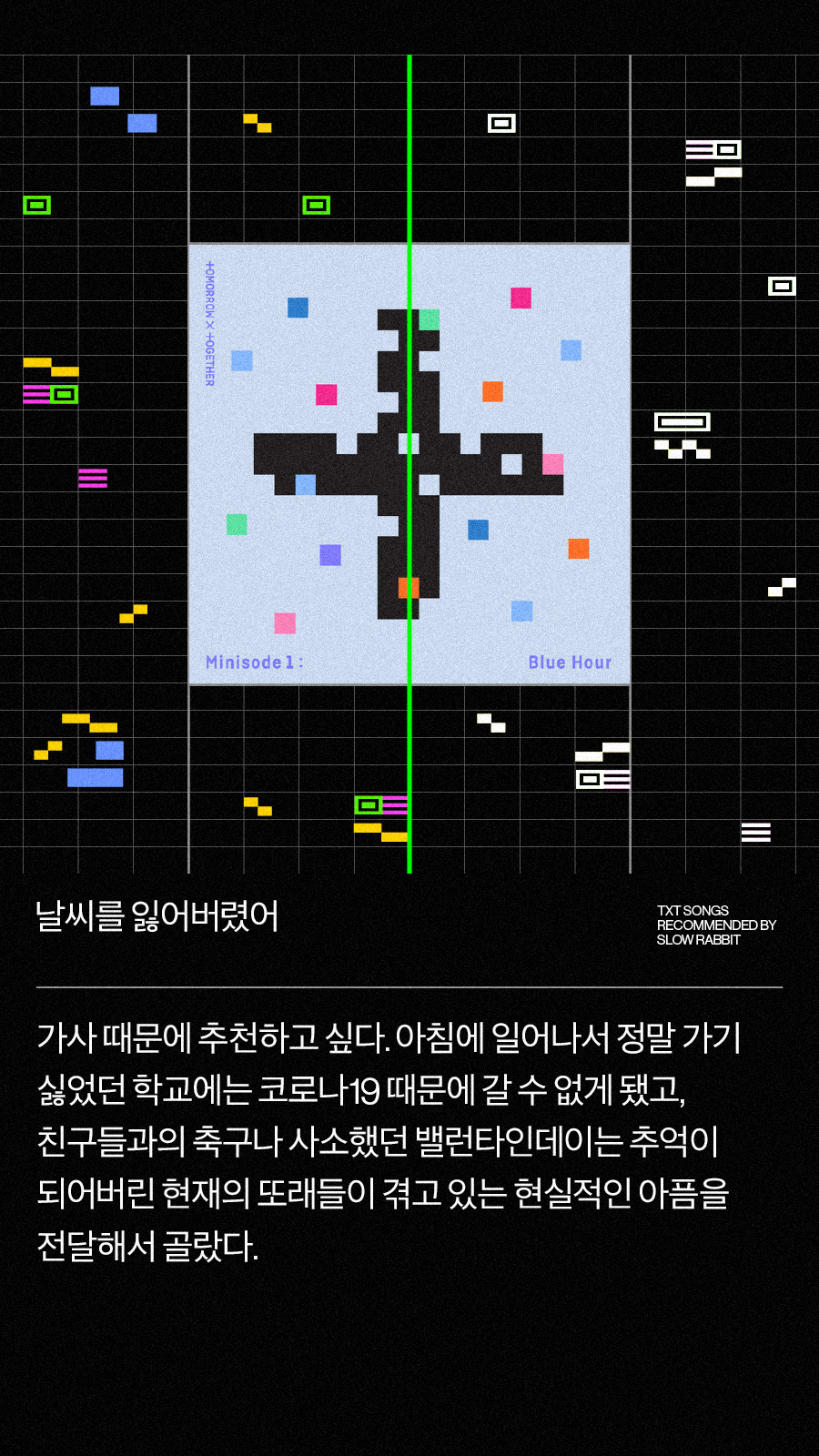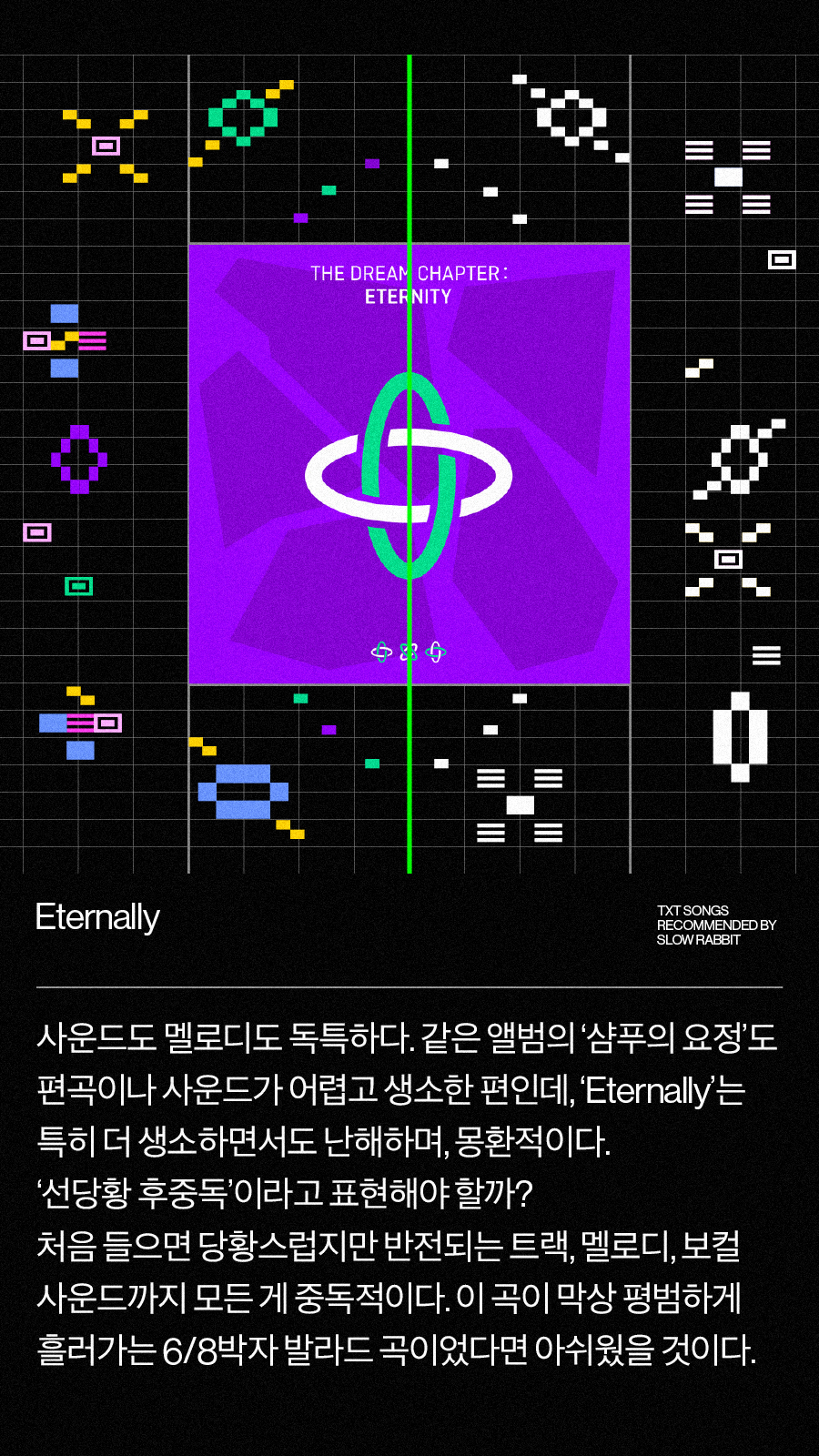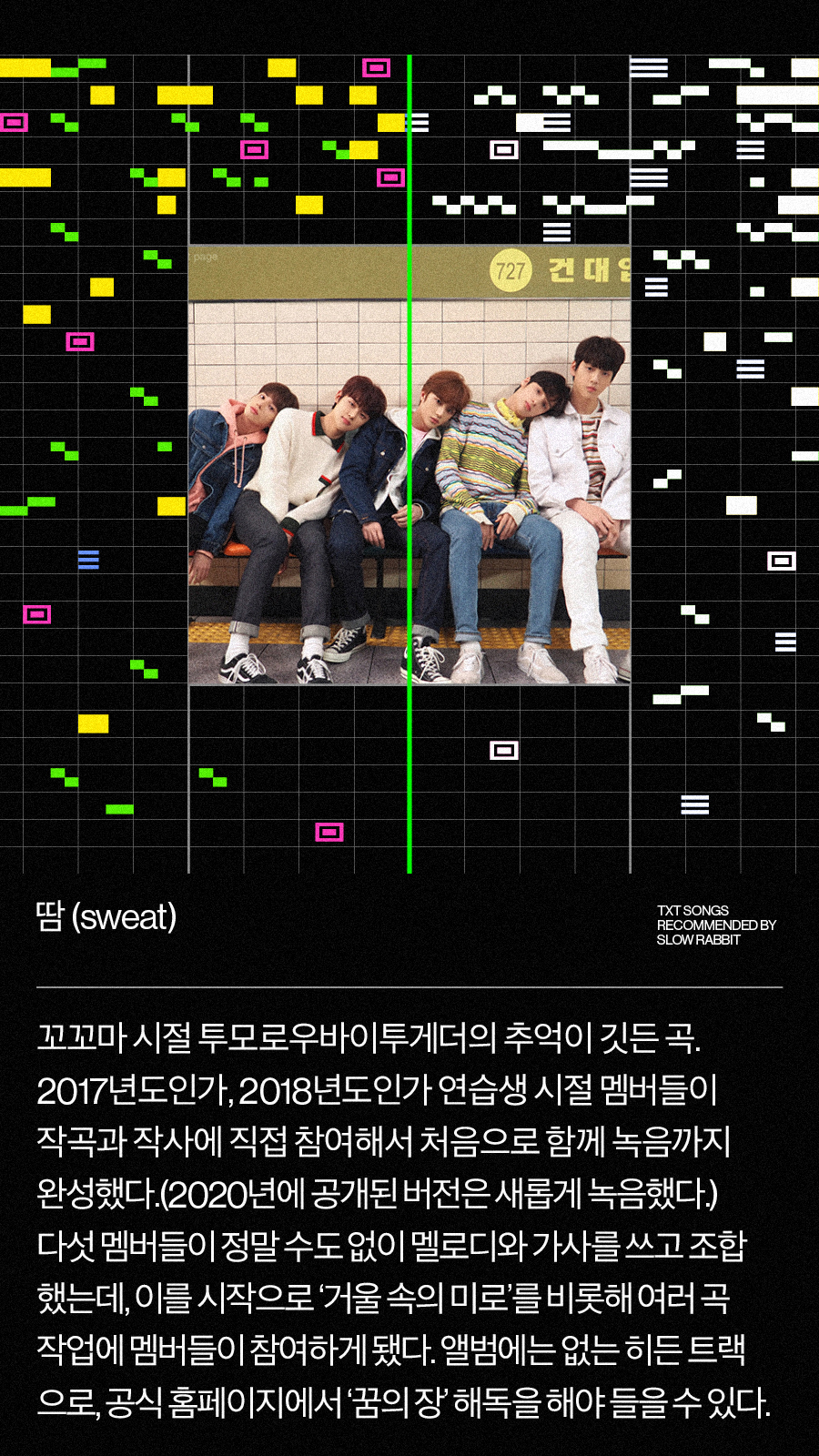
FEATURE
Map of the Big Hit Sound
BTS and TXT have the Big Hit sound
2021.03.08
Last year, among other songs, BTS released “ON” and “Life Goes On.” The two songs, which were the lead singles for the albums Map of the Soul: 7 and BE, respectively, have contrasting qualities. While “ON” features the kind of large-scale performance befitting BTS’s show at Seoul World Cup Stadium, the calm melody of “Life Goes On” is an amalgamation of the inner turmoil the members suffered during the pandemic. Supporting this melody, “Life Goes On” sports a reduced instrumentation and increases the gravity of the vocals enough that the listener can hear the breaths and small nuances in the members’ performances, resulting in a vivid yet delicate expression of emotions. By contrast, the space allotted to the vocals in “ON” is relatively small to bring out the horns, drums and layered chorus which suggest the grandeur of the stage. Over the course of a year, BTS moved between “ON,” “Dynamite,” and “Life Goes On,” showing off their ever-changing style. The sound of their music spanning that time describes in detail the kind of space that each song is trying to express: “ON” becomes a stadium concert exclusively through what is heard, while “Life Goes On,” like its accompanying music video, is close to a soliloquy given in a small room.
“I think a good song is one that paints a clear picture.” This sentiment, belonging to Pdogg, the producer overseeing their albums, intuitively describes BTS’s sound. “ON” is not made large in scale simply by piling on many sounds, but rather the wide space is filled with details from the numerous instruments and the chorus, creating several layers around and behind the vocals. The scope of the space described in “Life Goes On” is narrowed by the loud bass in front, percussion that seems to emanate out from directly next to the left ear and an ever-so-slightly wider clapping. “We tried to keep the energy seen in the performance for the music video while at the same time showing some of the loneliness behind it,” Pdogg says of recording “ON,” adding that “it was the start of making music where people could feel immersed in the performance.” In BTS’s music, sound is a means of conveying a song’s visual imagery using not only the left–right binary but also the three-dimensional space in front and behind—in other words, a mise-en-scène constructed through sound.
“Blue & Grey” is itself a sort of monologue that conveys the inner strife V was experiencing at the time he wrote the song, the distant, ringing reverb impressing the feeling of an unrealistic space upon the listener. RM’s rap creates a dreamlike atmosphere, moving from the center to the right speaker and back to the left. Yet the final lyrics—“After secretly sending my words up into the air / Now I fall asleep at dawn”—sound immediate, as though V is singing directly in front of the listener’s face. The composition is such that it seems to suggest V, who started the song with the question, “Where is my angel?” returns from deep contemplation to a monologue back in reality. The song “DNA” features lyrics like “providence of the universe” and “from the day of the universe’s creation” and, musically speaking, uses the atmospheric sounds of outer space and a rocket ship as part of the song. As these sounds pass by in the music video, the camera follows along with their movement while showing the backdrop of the vast universe behind Jung Kook and V as they dance. The sound and video are lined up with one another to create a unified picture and give shape to the premise, and each song has a different flavor of sound for this reason. The aim when recording a BTS song is not simply to make the vocals or certain beats stand out. In the words of Pdogg, their sound conveys “the essence of what we’re pursuing, what we want to express.”
“I think a good song is one that paints a clear picture.” This sentiment, belonging to Pdogg, the producer overseeing their albums, intuitively describes BTS’s sound. “ON” is not made large in scale simply by piling on many sounds, but rather the wide space is filled with details from the numerous instruments and the chorus, creating several layers around and behind the vocals. The scope of the space described in “Life Goes On” is narrowed by the loud bass in front, percussion that seems to emanate out from directly next to the left ear and an ever-so-slightly wider clapping. “We tried to keep the energy seen in the performance for the music video while at the same time showing some of the loneliness behind it,” Pdogg says of recording “ON,” adding that “it was the start of making music where people could feel immersed in the performance.” In BTS’s music, sound is a means of conveying a song’s visual imagery using not only the left–right binary but also the three-dimensional space in front and behind—in other words, a mise-en-scène constructed through sound.
“Blue & Grey” is itself a sort of monologue that conveys the inner strife V was experiencing at the time he wrote the song, the distant, ringing reverb impressing the feeling of an unrealistic space upon the listener. RM’s rap creates a dreamlike atmosphere, moving from the center to the right speaker and back to the left. Yet the final lyrics—“After secretly sending my words up into the air / Now I fall asleep at dawn”—sound immediate, as though V is singing directly in front of the listener’s face. The composition is such that it seems to suggest V, who started the song with the question, “Where is my angel?” returns from deep contemplation to a monologue back in reality. The song “DNA” features lyrics like “providence of the universe” and “from the day of the universe’s creation” and, musically speaking, uses the atmospheric sounds of outer space and a rocket ship as part of the song. As these sounds pass by in the music video, the camera follows along with their movement while showing the backdrop of the vast universe behind Jung Kook and V as they dance. The sound and video are lined up with one another to create a unified picture and give shape to the premise, and each song has a different flavor of sound for this reason. The aim when recording a BTS song is not simply to make the vocals or certain beats stand out. In the words of Pdogg, their sound conveys “the essence of what we’re pursuing, what we want to express.”
From “No More Dream” all the way to “Life Goes On,” BTS evolved musically thanks to the change in their sound and message. “In the group’s early days,” says Pdogg, “I thought it had to be extremely exciting to listen to, regardless of the listening environment, in order to impress as many people as possible.” Next to the BTS of their “No More Dream” days, the group today has demonstrated a much broader range musically in the past year with “ON,” “Dynamite” and “Life Goes On.” Looking beyond the “school trilogy,” the name that encompasses the group’s first three albums, the change takes place on the albums that follow in their songs: “Danger” (2014), with the space in front of and behind the song inventively widened; “I NEED U” (2015), so persistently filled with sounds that almost feels like a full orchestral arrangement; the anxious, dark feelings of a boy entering the adult world in “Blood Sweat & Tears” (2016), for which, Pdogg says, “compared to previous BTS songs, a completely different method of singing and approach” to vocal directing was used; “FAKE LOVE” (2018), the beginning and end of which double and overlap the members’ voices to give shape musically to the album’s “mask” theme; the list goes on. In that time, BTS’s message changed to keep pace with their growth and so an elaborately designed world of sound took form. According to Pdogg, this is the result of making an effort to “avoid repeating similar, related genres where possible, and to try to make changes, no matter how small.” Artists, of course, continuously face challenges in the process. To record the album BE, Pdogg revealed "the members had the difficult task of expressing their emotions within an unfamiliar vocal range, as they had to find the center among totally different voice types.” This, he says, is “because the times keep changing and artists’ voices reflect the zeitgeist of the era.”
Pdogg specifically points to 2014, when he was working to release “Danger,” as an important turning point in BTS’s sound. The recording session and mixing for “Danger” took place in the United States, where he shared ideas and discuss with the staff. There, he was able to make bold, unconventional attempts such as intentionally adding long delays or strong reverbs in the rap. This later inspired BTS to be flexible depending on each song’s direction and purpose. By the time they worked on the LOVE YOURSELF album, such experiments made even more diverse approaches possible with more investment made into the recording environment. “We worked remotely from Korea with engineers in the States,” Pdogg says. “We purchased and set up the same equipment used by the American engineers so we could effectively trade ideas about what direction the mix should take. That was made possible thanks to the financial investment,” he says, adding, “BTS actively give their opinions about the sound on the parts they work on; they say, ‘I think it should sound like this.’ ” Pdogg also reveals that, “especially in the case of BE, the members even participated in the mixing process and came up with plenty of ideas.” In short, the way Big Hit Entertainment proceeds with the album’s message and intricate performances in consideration of their unique sound is the result of taking on endless musical challenges, being open to new experiences and the growth of their artists.
“CROWN,” TOMORROW X TOGETHER’s debut song, opens with a series of Morse code pulses moving from the left speaker to the right. In this moment we realize just what the Big Hit sound that grew with BTS can do. At the time of their debut, the voices of the then-unknown TOMORROW X TOGETHER, like Morse code, are buried behind the many sounds in “CROWN,” and their very existence, as though once in hiding, appears as if poking its head out. The volume of the vocals is finely tuned in accordance with the direction the song takes, creating a three-dimensional space through various sounds to construct for the group their own world. The lyric, “But I like violet and / Wanna go to mountains,” from “Blue Orangeade” on the same album, is almost obsessive in the way each of the last three syllables sound different; the electric guitar-heavy and vocal-centric but minimalistic composition of “Nap of a star” daringly develops the vocals by building them up in two layers to create a fantastical soundscape. These techniques have become, in some ways, Big Hit’s signature.
Pdogg specifically points to 2014, when he was working to release “Danger,” as an important turning point in BTS’s sound. The recording session and mixing for “Danger” took place in the United States, where he shared ideas and discuss with the staff. There, he was able to make bold, unconventional attempts such as intentionally adding long delays or strong reverbs in the rap. This later inspired BTS to be flexible depending on each song’s direction and purpose. By the time they worked on the LOVE YOURSELF album, such experiments made even more diverse approaches possible with more investment made into the recording environment. “We worked remotely from Korea with engineers in the States,” Pdogg says. “We purchased and set up the same equipment used by the American engineers so we could effectively trade ideas about what direction the mix should take. That was made possible thanks to the financial investment,” he says, adding, “BTS actively give their opinions about the sound on the parts they work on; they say, ‘I think it should sound like this.’ ” Pdogg also reveals that, “especially in the case of BE, the members even participated in the mixing process and came up with plenty of ideas.” In short, the way Big Hit Entertainment proceeds with the album’s message and intricate performances in consideration of their unique sound is the result of taking on endless musical challenges, being open to new experiences and the growth of their artists.
“CROWN,” TOMORROW X TOGETHER’s debut song, opens with a series of Morse code pulses moving from the left speaker to the right. In this moment we realize just what the Big Hit sound that grew with BTS can do. At the time of their debut, the voices of the then-unknown TOMORROW X TOGETHER, like Morse code, are buried behind the many sounds in “CROWN,” and their very existence, as though once in hiding, appears as if poking its head out. The volume of the vocals is finely tuned in accordance with the direction the song takes, creating a three-dimensional space through various sounds to construct for the group their own world. The lyric, “But I like violet and / Wanna go to mountains,” from “Blue Orangeade” on the same album, is almost obsessive in the way each of the last three syllables sound different; the electric guitar-heavy and vocal-centric but minimalistic composition of “Nap of a star” daringly develops the vocals by building them up in two layers to create a fantastical soundscape. These techniques have become, in some ways, Big Hit’s signature.
As the group to emerge on the heels of BTS, TOMORROW X TOGETHER are, above all else, paving the way for the Big Hit Entertainment sound, shaping an entirely different world through their music. Slow Rabbit, the producer for the group’s albums, says he “thought TOMORROW X TOGETHER’s music should have its own charm, different from BTS,” adding, “Right from their debut, TOMORROW X TOGETHER performed some retro-sounding music, and even when it was the same kind of retro, we tried to show off the group’s unique sensibilities with a fun and fresh sound to avoid any sense of déjà vu.” He says he “tried experimental sounds” in “Can’t You See Me?” off of The Dream Chapter: ETERNITY, with sounds in the chorus akin to an explosion wrapping itself around the vocals in a dark, disturbing space. Similarly, SOOBIN and YEONJUN’s voices saying “save me” are separated from the other vocals and nearly caught right in front of the listener, resulting in an effect not unlike a scene out of a movie where the character tries to escape a lonely place. In “Fairy of Shampoo,” a cover of a song by The Light and the Salt, there is a clear difference between the lyrics which describe a certain “her” existing only in a virtual world, and the texture of the realistic voice in the chorus announcing their plan to love her. Consequently, it is transformed—from a song about the epitome of the screen in the new era born out of 1990s media, into a song that conveys the voices of the members who, although idols and therefore an ideal presence on the screen, are also real people on the border of youth. Slow Rabbit says he “tried to include mysterious and dreamy sounds that aren’t often heard in pop music” when producing “Fairy of Shampoo.” Having appeared almost overnight in the middle of the K-pop world, TOMORROW X TOGETHER’s essence begins with a sound that embodies the quiet cracks along the boundary between reality and fantasy.
“The current direction of Big Hit Entertainment’s sound is different from how it was before. Considering pop music’s current trends, we’re aiming for a sound that’s different from the past. So instead of saying, ‘This is our music,’ and sticking to that, we keep changing it to keep up with the trends.” Here, Slow Rabbit succinctly describes Big Hit Entertainment’s sound. Trends are constantly evolving, and music producers stay in line with the changes by continually trying out different genres and styles. At the same time, the music should be produced in such a way that artists performing under the K-pop umbrella can adopt it and, moreover, it should be adjusted to suit each artist’s individuality and growth. In the same way that the success of the K-pop industry is rooted in mixing together various genres and modern entertainment staples like music, dance, music videos and social media, K-pop music must take all of this into consideration and condense it into a three-minute song. The Big Hit Entertainment sound is a comprehensive collection of all those changes and a question that starts over again once it reaches its conclusion. How should the current K-pop sound take shape in global music trends, different tastes across the K-pop fan world and the unique world each artist creates to capture their fanbase’s attention? Rather than looking for one fixed answer to these questions, the sound of Big Hit Entertainment prepares different answers as necessary instead. Perhaps Pdogg’s look back on his time since the debut of BTS provides a part of the answer: “Every moment had its challenges.”
“The current direction of Big Hit Entertainment’s sound is different from how it was before. Considering pop music’s current trends, we’re aiming for a sound that’s different from the past. So instead of saying, ‘This is our music,’ and sticking to that, we keep changing it to keep up with the trends.” Here, Slow Rabbit succinctly describes Big Hit Entertainment’s sound. Trends are constantly evolving, and music producers stay in line with the changes by continually trying out different genres and styles. At the same time, the music should be produced in such a way that artists performing under the K-pop umbrella can adopt it and, moreover, it should be adjusted to suit each artist’s individuality and growth. In the same way that the success of the K-pop industry is rooted in mixing together various genres and modern entertainment staples like music, dance, music videos and social media, K-pop music must take all of this into consideration and condense it into a three-minute song. The Big Hit Entertainment sound is a comprehensive collection of all those changes and a question that starts over again once it reaches its conclusion. How should the current K-pop sound take shape in global music trends, different tastes across the K-pop fan world and the unique world each artist creates to capture their fanbase’s attention? Rather than looking for one fixed answer to these questions, the sound of Big Hit Entertainment prepares different answers as necessary instead. Perhaps Pdogg’s look back on his time since the debut of BTS provides a part of the answer: “Every moment had its challenges.”
Article. Rieun Kim
Design. Paperpress
Visual Director. Yurim Jeon
Copyright © Weverse Magazine. All rights reserved.
Unauthorized reproduction and distribution prohibited.
Unauthorized reproduction and distribution prohibited.
Read More
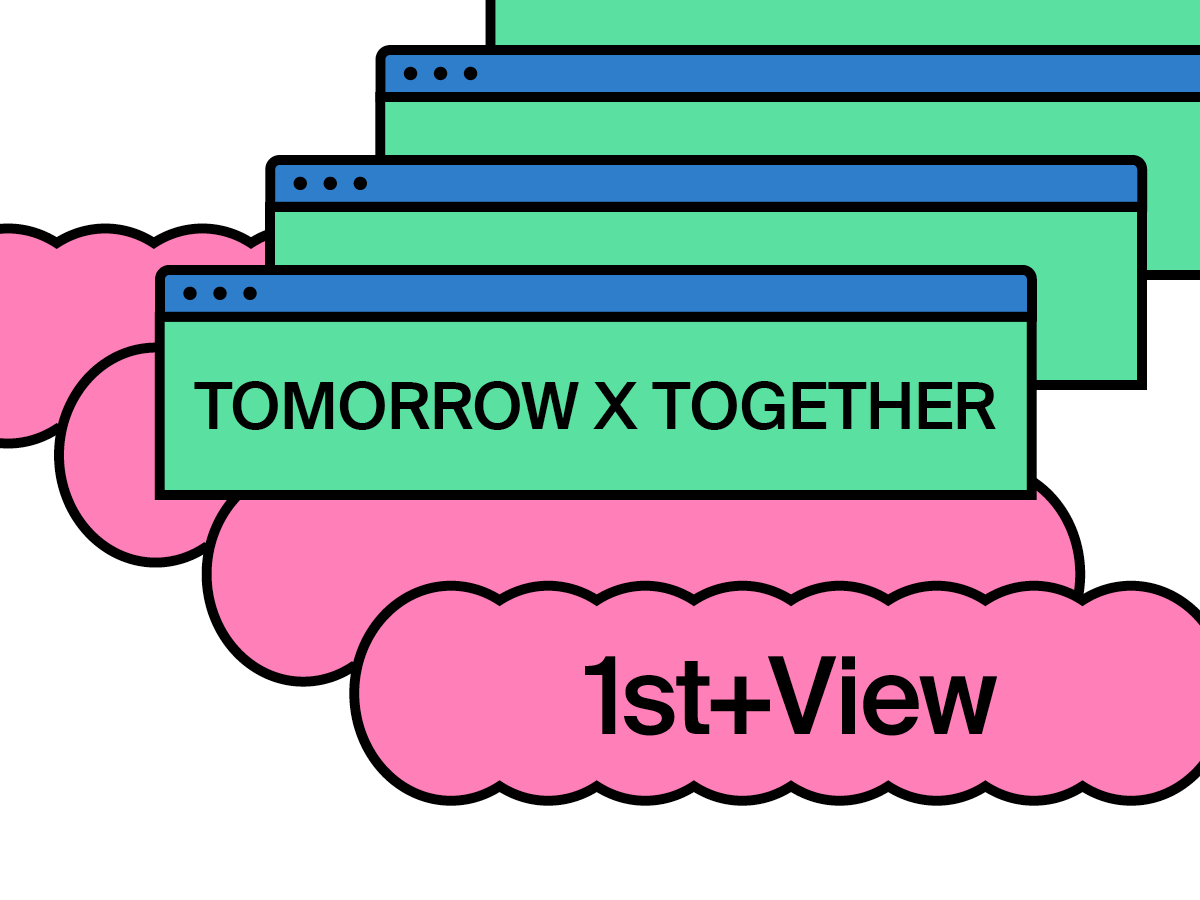

- BTS set 15 new records with BE2020.12.14
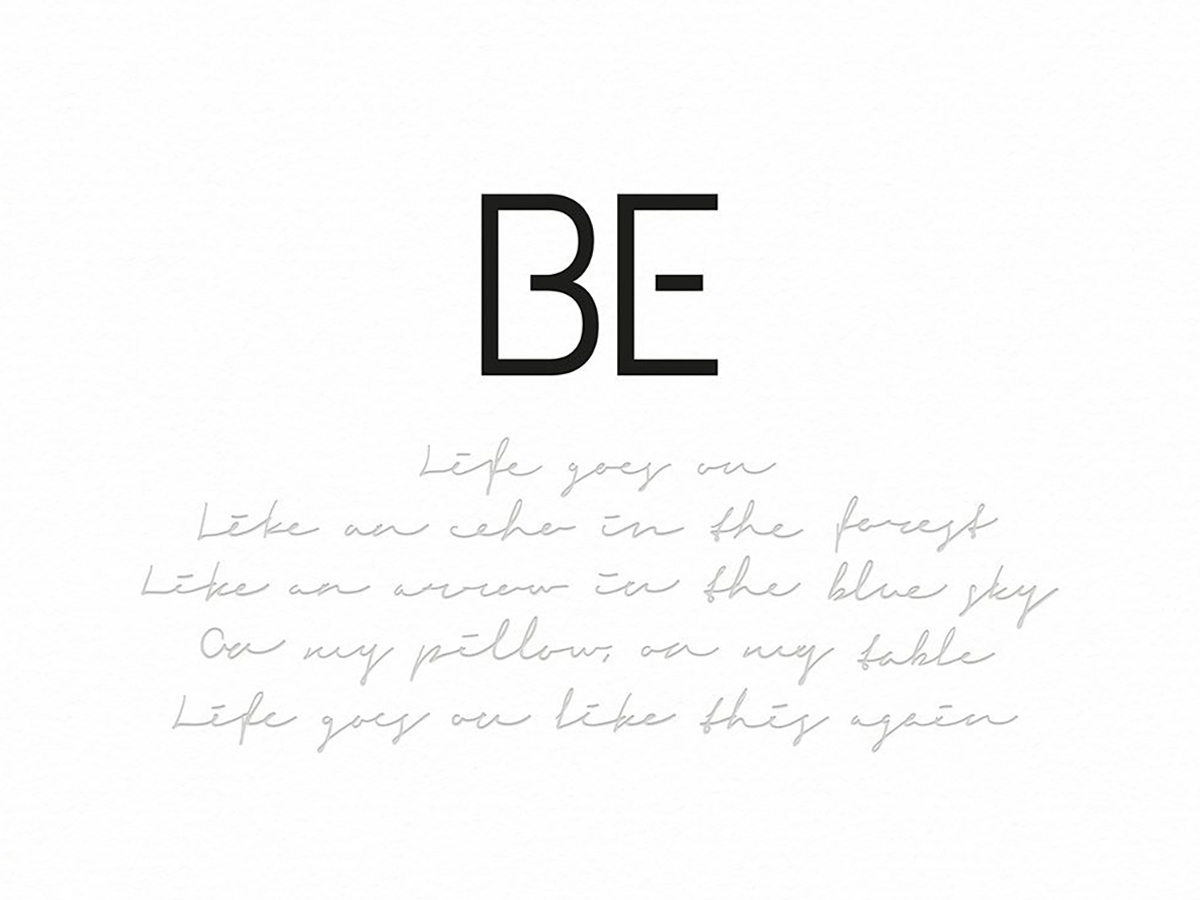
- The Life of BTS Writes a Story2020.11.30
